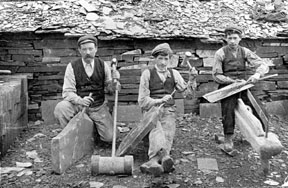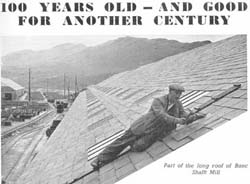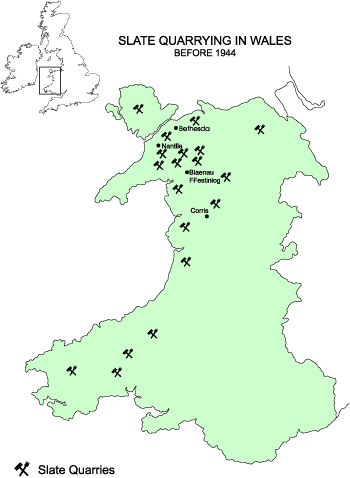The History of Quarrying
 The use
of slate in the area goes back to the Roman period. The fort at Segontium, (Caernarfon), originally had tiled roofs, which were
replaced at a later date with slate. Some of the floors were made
of slate slabs in the fourth century. But slate was also used in
a much earlier Roman fort at Caer Llugwy, between Capel Curig and
the Conwy Valley two centuries before. Slate was used for roofing
the eight towers of Conwy Castle between 1283-87. Indeed, during
the Welsh wars of Independence, Edward I, of England, while
visiting the copper mines of Drws y Coed, is reputed to have
stayed at a house in the Nantlle Valley roofed with slates from
the Cilgwyn Quarry. In 1317, the great hall of Llywelyn II,
(Llywelyn the Last), was removed from Conwy to Caernarfon Castle
and slated by one 'Henry le Scaltiere.' Seventy years later, in
1387, John Trevisa in a translation of Ranulf Higden's
Polychronicon noted: The use
of slate in the area goes back to the Roman period. The fort at Segontium, (Caernarfon), originally had tiled roofs, which were
replaced at a later date with slate. Some of the floors were made
of slate slabs in the fourth century. But slate was also used in
a much earlier Roman fort at Caer Llugwy, between Capel Curig and
the Conwy Valley two centuries before. Slate was used for roofing
the eight towers of Conwy Castle between 1283-87. Indeed, during
the Welsh wars of Independence, Edward I, of England, while
visiting the copper mines of Drws y Coed, is reputed to have
stayed at a house in the Nantlle Valley roofed with slates from
the Cilgwyn Quarry. In 1317, the great hall of Llywelyn II,
(Llywelyn the Last), was removed from Conwy to Caernarfon Castle
and slated by one 'Henry le Scaltiere.' Seventy years later, in
1387, John Trevisa in a translation of Ranulf Higden's
Polychronicon noted:
|
Valeys bryngeth forth food,
And hills metal right good,
Col groweth under lond,
And grass above at the hond,
There lyme is copious,
And sclattes also for hous.
|
Around 1358-60, building repairs were carried out at Chester,
under the supervision of the Black Prince, when '21,000 slate
stones' were bought for the roof of the great stable at
Chester Castle. And when Richard II, of England arrived at Conwy
in 1399, a year before the Rebellion of Owain Glyndwr, a
Frenchman named Creton depicted:
|
So rode the King, without making noise,
That at Conwy, where there is much slate
On the houses, he arrived, with scarce a pause,
At break of day.
|
These slates were probably obtained from the quarries at
Dolwyddelan or Penmachno.
Another thread of evidence comes from the poetical works of Iolo
Goch c1320-c1398 that Owain Glydwr's court at Sycharth; Llansilin
appears to have had a slate roof.
|
A high house with a stone (slate) roof
Chimneys for the gathering of smoke?
|
Towards the end of the fifteenth century, the poet Guto'r Glyn
wrote a cywydd* on behalf of Sir Gruffudd ab Einion who
lived in the Vale of Clwyd.
|
'My only job for him from Bangor
Was to order slates on the arm of the sea.
A cairn from the isle of Gwynedd
In a large ship, as wide as a palace?
Carried to Tegeingl will they be,
To Rhuddlan and to Henllan.'
|
Close to a century later, Sion Tudur wrote a cywydd
asking the Dean of Bangor for a gift of a load of slates.
|
'The ship, with its strong anchor
Will carry twenty thousand (slates) over the deep sea;
Which will be unloaded
On the fair land of Rhuddlan.'
|
 John Leland during his travels between 1536-39
remarked that 'the houses withyn the town
of Oswestre be of tymbre and slated' and at Is Dulas, on
the eastern side of the River Dulas in Denbighshire, 'they
dig oute slate stones to kyver houses.' Slates were also used
on houses in Wrexham during the reign of Elizabeth I. During the
episcopacy of William Morgan, (translator of the Bible into
Welsh) at St. Asaph, (1601-04) the cathedral chancel was slated.
In 1682, more slating with Penrhyn slates took place and during
renovation in the 1930's, these slates, which were by then over
250 years old were strong enough to be re used on new
timbers. John Leland during his travels between 1536-39
remarked that 'the houses withyn the town
of Oswestre be of tymbre and slated' and at Is Dulas, on
the eastern side of the River Dulas in Denbighshire, 'they
dig oute slate stones to kyver houses.' Slates were also used
on houses in Wrexham during the reign of Elizabeth I. During the
episcopacy of William Morgan, (translator of the Bible into
Welsh) at St. Asaph, (1601-04) the cathedral chancel was slated.
In 1682, more slating with Penrhyn slates took place and during
renovation in the 1930's, these slates, which were by then over
250 years old were strong enough to be re used on new
timbers.
Another secular building, with ecclesiastical links was Plas y
Gogarth, near Llandudno. This was owned by the Bishop of Bangor,
and which was roofed in the thirteenth century. All in all, the
picture we have is of slates being used on the better kind of
house in North Wales at this time, a time which saw a great deal
of building activity. Slates from the Glyn Ceiriog area were
available in 1675. However, it must be kept in mind that apart
from castles and cathedrals, it was not uncommon
in Wales to use slates for roofing at this time. Any
transportation involved the use of ships. Indeed, the chief
export of the area by Tudor times was slate, as up to 1603,
there are references of slate being exported from Aberogwen(Bangor),
to Dublin and Carlingford in Ireland as well as the Foryd (Rhyl),
St. Asaph and Chester. Slates from Pembrokeshire were exported to
the south east coast of Ireland as well as Bristol. It is also interesting to
note that slates from Antwerp were imported
into London in 1567 to re-roof the Royal Exchange at London. More recently, Welsh slate was used to roof the Palace of
Westminster in the nineteenth century, for the electricity panels
of the Cunard liners, Queen Mary and the Queen Elizabeth in the
1930's, as a damp course for the new cathedral at Guildford in
1960 as well as re-roofing the whole of Downing Street in
1962-63.

By comparison with the Welsh iron, coal, copper and lead
industries, the slate industry was indeed very primitive as late
as 1750, even though two million slates appear to have been
exported from Caernarfon in the 1730's. By 1790, slates were
exported not only to various Welsh ports, but to at least
eighteen English ports, ten Irish ports and two Scottish ports,
apart from Boulogne, Dunkirk and Rotterdam on mainland Europe.
Substantial development was very slow. By 1832, the annual
output of slates from the north Wales quarries was 100,000 tons.
By 1882 it was over 450,000 tons, only to decline by 1972 to
about 22,000 tons. The Slate industry reached its dramatic zenith
in a very short period of time. Its decline was also just as
dramatic. Up to around 1750 all the Welsh slate quarries were
very small and shallow excavations and were worked by local
people for their own individual needs or for sale. This had been
happening for centuries. In 1413, Gwilym ap Griffith of Penrhyn
paid a number of his tenants 10d each for working 5,000 slates. A
burgess of Beaumaris leased land to raise slates on the Penrhyn
estate in Llandygai in 1544. By 1568-69, when he died at Bangor,
it was noted that a William Spen of Denbigh owed him for 13,000
slates. All in all, the landowners did not show much interest in
exploiting their rights.
*
Alliterative Welsh poem
|